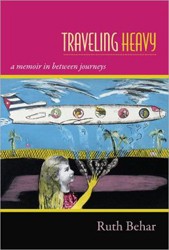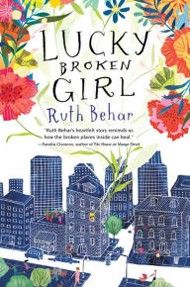This book is composted of fascinating vignettes of the community of Jews encountered by Ruth Behar on her many trips back to her birthplace. The author left Cuba as an exile at the age of five, along with the large exodus that began when Fidel Castro came to power. She began journeying to Cuba to seek out the past, of which she had no memories. Behar wondered who and what was left to uphold the Jewish legacy of the island and recorded her findings in this fascinating book.
Behar, who is an anthropology professor at the University of Michigan and the recipient of a MacArthur Fellows award, describes the people and sights of her beloved homeland with compassion and an eye for colorful detail. She includes interesting dialogye from conversations she has with the locals. Her book includes many poignant black and white photos by award winning Cuban photographer Humberto Mayol, which enhance the personal narratives of individuals within the remaining Jewish community.
This book was especially enjoyable for me because I share the same heritage and quest as the author and experienced what she wrote about. My Yiddish speaking grandparents arrived in Cuba from Poland and Russia before World War II and made successful lives there, raising their families and working hard. I left Havana in 1962 at the age of thirteen months with my parents and most of our extended family as refugees to the U.S. Like Behar, I grew up in a Cuban-Jewish-American immigrant environment, speaking fluent Spanish, eating delicious Cuban specialties, and loving Latino music. I yearned for many years to visit the island where my paternal uncle still lives and see for myself what is left of the once thriving Jewish community my parents told me so much about.
Reconnecting via email with my family in Cuba piqued my fervor to travel there. But hearing Behar present her book with a slide show of its photographs a year ago was final straw to convince my reluctant mother to visit the “forbidden” island of Cuba with me. Behar says, exiled Cubans have always been called gusanos, or worms by Fidel, and traveling back is highly restricted by the U.S. My dream came true last December as I participated in a Chanukah humanitarian mission with my Cuban-born mother. Like some Cuban Americans, my father voiced strong negativity about returning to Cuba and didn’t join us. But my mother and I enjoyed the trip immensely, and she laughed and cried upon seeing things she remembered or had forgotten in the last 47 years as we visited all the landmarks that were meaningful in her life as a Cuban Jew.
We were saddened by the neglect and deterioration of the island’s infrastructure, but this allowed us to see Cuba nearly as it was 50 years ago when my parents’ generation lived there. The Jewish community has shrunk from 15,000 to 1500. Only about 100 old timers are left to relay the past, helped by visiting Jewish communal volunteers from abroad. Aid is supplied by the many visitors like us who arrive at Jose Marti airport with suitcases bursting with donations of medicines, clothes, and religious objects.
Our trip included all of Havana’s Jewish institutions as well as a talk with David Tacher, Santa Clara’s Jewish community leader in the work-in-progress new Jewish center funded by donors from abroad. In the fishing town of Caibarien we visited the last remaining Jewish family and Julio Rodriguez Eli is pictured in the book. His son, like other young Cubans including my cousin, has recently made Aliyah. We enjoyed quality time with my uncle whom I saw only once since 1962 because of estrangement in our family due to the political situation, a common occurrence in Cuban families. We met many of the personalities depicted by Behar and although I read the book before the trip, I rushed to reread it upon my return, amazed that I had actually seen much of what she narrated in her stories.
I am grateful that I have successfully accomplished my goal to experience my birthplace, but like Behar, I was left with a strong desire for future visits. An Island Called Home is a snapshot of Cuban Jewish life and well worth a read by anyone interested in the beloved but mystifying island so close to home in America.
Miriam Bradman Abrahams, mom, grandmom, avid reader, sometime writer, born in Havana, raised in Brooklyn, residing in Long Beach on Long Island. Longtime former One Region One Book chair and JBC liaison for Nassau Hadassah, currently presenting Incident at San Miguel with author AJ Sidransky who wrote the historical fiction based on her Cuban Jewish refugee family’s experiences during the revolution. Fluent in Spanish and Hebrew, certified hatha yoga instructor.





